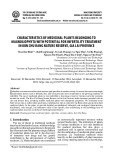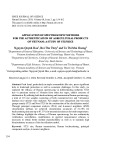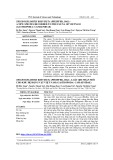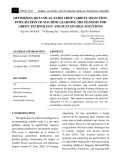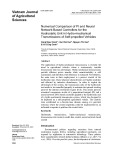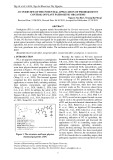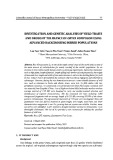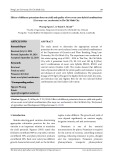
170 Nong Lam University, Ho Chi Minh City
The Journal of Agriculture and Development 23(Special issue 1) www.jad.hcmuaf.edu.vn
Enhancing the oil extraction process and exploring phytochemical composition
and bioactivities of bitter melon seeds (Momordica charantia L.)
Anh T. V. Nguyen1, Thu T. A. Pham1, Hien T. Dang1, Linh T. Pham1, & Hong V. C. Phung2*
1Faculty of Biological Sciences, Nong Lam University, Ho Chi Minh City, Vietnam
2Research Institute for Biotechnology and Environment, Nong Lam University, Ho Chi Minh City, Vietnam
ARTICLE INFO ABSTRACT
Research Paper
Received: August 03, 2024
Revised: October 28, 2024
Accepted: October 29, 2024
Keywords
Bitter melon seeds
Lipid
Quality requirements
Secondary compounds
*Corresponding author
Phung Vo Cam Hong
Email: hongpvc@hcmuaf.edu.vn
This study was conducted to determine the phytochemical
composition of bitter melon seeds (Momordica charantia L.) grown
in Long An province (Vietnam), to investigate optimal conditions
for lipid extraction, and to evaluate the extracted lipid’s quality. The
seeds had a moisture content of 5.27%, total ash of 1.85%, total
flavonoid content of 91.10 mg/100 g, and total polyphenol content
of 478.95 mg/100 g. The seeds were also free of highly toxic metals
such as lead and cadmium. Using the Soxhlet method, optimal
lipid extraction was achieved with a material-to-solvent ratio of
1:80 (w/v) over 4 hours, resulting in a lipid extraction efficiency
of 13.74%. The acid, saponification, ester, and peroxide values
were 1.01 mg KOH/g, 355.60 mg KOH/g, 354.59 mg KOH/g,
and 3.82 meq O2/kg, respectively, in compliance with the quality
requirements of Vietnam and Codex standards. The extracted
lipids had antioxidant activity at an IC50 value of 119 mg/mL
and inhibited the growth of two microbial strains Staphylococcus
aureus and Bacillus subtilis subsp. spizizenii. These findings
suggest that bitter melon oil has potential applications in the food,
pharmaceutical, and cosmetic industries
Cited as: Nguyen, A. T. V., Pham, T. T. A., Dang, H. T., Pham, L. T., & Phung, H. V. C. (2024).
Enhancing the oil extraction process and exploring phytochemical composition and bioactivities of
bitter melon seeds (Momordica charantia L.). The Journal of Agriculture and Development 23 (Special
issue 1), 170-187.

Nong Lam University, Ho Chi Minh City 171
The Journal of Agriculture and Development 23(Special issue 1) www.jad.hcmuaf.edu.vn
Figure 1. Graphic abstract.
maceration, and shaking water bath extraction,
are widely used for their simplicity and cost-
effectiveness. However, these methods often
require long extraction times and involve the use
of harmful solvents (Pitipanapong et al., 2007;
Zaini et al., 2018; Sasongko et al., 2019). On the
other hand, advanced techniques like Soxhlet
extraction, ultrasonics, supercritical CO2 (SC-
CO2) extraction, and enzyme-assisted methods
offer greater efficiency, reduced extraction time,
lower solvent consumption, and better selectivity
(Nyam et al., 2009; Xu et al., 2014; Naik et al.,
2021), though they come with higher costs and
more complex procedures.
The choice of extraction method depends on
various factors such as the chemical structure and
physicochemical properties of the sample, as well
as the research objectives. Thus, the objective of
the study aimed to develop a simplified extraction
method for bitter melon seeds to produce oil that
complies with safety standards, retains the seeds’
bioactive components, extends shelf life, and is
suitable for multiple applications (Figure 1).
1. Introduction
Momordica charantia Linn (M. charantia L.),
commonly known as bitter melon, is an annual
climbing vine from the Cucurbitaceae family.
Besides its widespread use as a food in many
countries, bitter melon has long been used in
traditional medicine throughout Asia, Africa, and
Latin America due to its rich content of over 60
bioactive phytochemicals, including glycosides,
saponins, alkaloids, fixed oils, triterpenes,
proteins, and steroids (Behera et al., 2020).
Notably, bitter melon seed oil has been applied
in treating various diseases such as diabetes,
inflammation, and cancer, and is also utilized
in cosmetics, poultry, aquaculture feed, and
biodiesel production (Horax et al., 2010; Ajuru et
al., 2017; Singh et al., 2019). The oil is composed
of monounsaturated fatty acids (MUFA),
saturated fatty acids (SFA), and polyunsaturated
fatty acids (PUFA), with conjugated linoleic acid
(CLnA) as the predominant component (Liu et
al., 2010; Yoshime et al., 2016).
Traditional extraction techniques for plant-
derived bioactive compounds, such as pressing,

172 Nong Lam University, Ho Chi Minh City
The Journal of Agriculture and Development 23(Special issue 1) www.jad.hcmuaf.edu.vn
5 ± 0.0001 g into the moisture dish (which was
dried at 105°C, cooled, and recorded its mass).
The dishes containing the samples were placed
in a drying oven and dried at 105 ± 2°C for 4 - 6
h. Subsequently, they were transferred to a desic-
cator until reaching room temperature, and their
mass was re-recorded. This process was repeated
multiple times until the difference in weight be-
tween two consecutive weighings did not exceed
5 mg. The moisture content of the raw material
was calculated using the equation (1):
where mo, m1, and m2 was the mass of the mois-
ture dish, the mass of the moisture dish and the
sample before drying, and the mass of the mois-
ture dish and the sample after drying (g), respec-
tively.
Qualitative analysis
Seeds extract preparation: Two types of
solvents (70% ethanol and distilled water) were
used for extraction. Five g of seed powder were
soaked in 30 mL of each solvent. Then, coupled
with 20 mL of the same solvents, the residues
were extracted by ultrasound-assisted extraction
for 15 min. The extract was filtered through a
Whatman No.1 filter paper and stored at 4°C for
further use.
The biochemical compositions of the seed
extracts, including alkaloids, flavonoids, phenolic
acids, saponins, and tannins, were qualitatively
determined as previously described by Pham et
al. (1998) (Table 1).
2. Materials and Methods
2.1. Materials
The fruit of M. charantia L. was purchased
from a garden in Long An province, Vietnam.
After removing impurities and separating the
seeds from the flesh, they were dried at 50 ±
5°C until their moisture content was below 13%.
The dried seeds were then crushed and sieved
through a 1 mm diameter sieve. Raw powder was
stored in zip-lock bags at room temperature until
further use.
The equipment used in this study included
a reflux extraction system (Isolab, Germany),
a Soxhlet extraction system, an ultrasonic
cleaner (WUC-32, Jiayuanda, China), an
evaporator (Heidolph, Germany), a drying
oven (Memmert, Germany), and an ultraviolet-
visible spectrophotometer (Model 752N, Jenway,
England).
Chemicals used in the study included
Dragendorff (Cas#39775-75-2) and Wagner
reagents (Cas#39775-75-2), NaOH (Cas#1310-
73-2, Xilong), HCl (Cas#D1128, Duksan),
FeCl3 (Cas#7705-08-0, Xilong), hexane
(Cas#110-54-3, Xilong), Folin-Ciocalteu
reagent (Cas#1090010100, Merck), Na2CO3
(Cas#1063920500, Merck), phenolphthalein
(Cas#77-09-8), KOH (Cas#1310-58-3, Xilong),
Na2S2O3.5H2O (Cas#10102-17-7), and KI
(Cas#7681-11-0, Xilong).
2.2. Methods
2.2.1. Phytochemical analysis of bitter melon seeds
Determination of moisture content
The moisture content was determined
according to TCVN 7975:2008 (VS, 2008). Ini-
tially, the raw material was accurately weighed to
FeCl3 (Cas#7705-08-0, Xilong), hexane (Cas#110-54-3, Xilong), Folin-Ciocalteu reagent 86
(Cas#1090010100, Merck), Na2CO3 (Cas#1063920500, Merck), phenolphthalein (Cas#77-87
09-8), KOH (Cas#1310-58-3, Xilong), Na2S2O3.5H2O (Cas#10102-17-7), and KI 88
(Cas#7681-11-0, Xilong). 89
2.2. Methods 90
2.2.1. Phytochemical analysis of bitter melon seeds 91
Determination of moisture content 92
The moisture content was determined according to TCVN 7975:2008 (VS, 2008). 93
Initially, the raw material was accurately weighed to 5 ± 0.0001 g into the moisture dish 94
(which was dried at 105°C, cooled, and recorded its mass). The dishes containing the 95
samples were placed in a drying oven and dried at 105 ± 2°C for 4 - 6 h. Subsequently, 96
they were transferred to a desiccator until reaching room temperature, and their mass was 97
re-recorded. This process was repeated multiple times until the difference in weight 98
between two consecutive weighings did not exceed 5 mg. The moisture content of the raw 99
material was calculated using the equation (1): 100
W= m1- m2
m1- mo
˟ 100 (1)
101
where mo, m1, and m2 was the mass of the moisture dish, the mass of the moisture dish and 102
the sample before drying, and the mass of the moisture dish and the sample after drying 103
(g), respectively. 104
Qualitative analysis 105
Seeds extract preparation: Two types of solvents (70% ethanol and distilled water) 106
were used for extraction. Five g of seed powder were soaked in 30 mL of each solvent. 107
Then, coupled with 20 mL of the same solvents, the residues were extracted by ultrasound-108
assisted extraction for 15 min. The extract was filtered through a Whatman No.1 filter 109
paper and stored at 4°C for further use. 110

Nong Lam University, Ho Chi Minh City 173
The Journal of Agriculture and Development 23(Special issue 1) www.jad.hcmuaf.edu.vn
Table 1. Phytochemical screening methods of seed extracts
Compounds Reagents Observations (Indicating Positive Test)
Alkaloids Wagner Formation of brown to reddish brown pre-
cipitate
Dragendroff Formation of red-orange to red precipitate
Flavonoids NaOH 10%/HCl 10%
The color changed to red-orange or orange
and became lighter or discolored
when HCl was added.
Metal magnesium/HCl conc. The solution was pink to red.
Phenolic acids FeCl3 5% The solution was moss-green to bluish-black
Iodine The solution was red
Saponins Foam test Persistent foam for 15 min
Tannins FeCl3 5% The solution was moss-green to bluish-black
Lead acetate 10% Formation of white precipitate
Quantitative analysis
Based on the qualitative results, the main biological components of the seed extracts were
quantified, as presented in Table 2.
Table 2. Quantitative analysis methods of seed extracts
Compounds Methods
Flavonoids
Flavonoids were measured using the aluminum chloride colorimetric assay. Flavo-
noids in the sample were extracted using ethanol and mixed with aluminum chloride
(AlCl3) and potassium acetate (CH3COOK), leading to the formation of a yellow-col-
ored complex. The reaction mixture was incubated for 30 minutes, after which the
absorbance was measured using a UV-Vis spectrophotometer at 415 - 430 nm. The
total flavonoid content was quantified using a standard curve generated with querce-
tin as the reference compound (Chang et al., 2002).
Polyphenols
The total polyphenol content was quantified by the Folin-Ciocalteu (FC) method
(Waterman & Mole, 1994). The FC reagent was used to quantify total polyphenol
content through a redox reaction, where phenolic compounds were oxidized by do-
nating electrons to molybdenum (Mo) and tungsten (W) complexes in the reagent,
reducing them from Mo(VI) and W(VI) to Mo(V) and W(V). This reduction pro-
duced a blue color, with the intensity proportional to the polyphenol concentration.
The reaction required an alkaline medium, typically provided by sodium carbonate,
to enhance phenolic reactivity by deprotonating them into phenoxide ions. The blue
complex’s absorbance was measured at 765 nm, and the results were expressed as
gallic acid equivalents (GAE). Gallic acid was used as a control.

174 Nong Lam University, Ho Chi Minh City
The Journal of Agriculture and Development 23(Special issue 1) www.jad.hcmuaf.edu.vn
flask and the oil after drying (g), and h was the
moisture of the sample (%).
Soxhlet extraction
One gram of the sample was placed into a
Soxhlet extraction thimble (Isolab, Germany).
Reflux extraction was performed for 4, 6, and 8 h
using material-to-solvent ratios of 1:60, 1:80, and
1:100 (w/v). Hexane remained the solvent used
in this method. After extraction, the solvent was
removed by a rotary evaporator and the results
were calculated according to formula (2).
Ultrasonic extraction
One gram of the sample was weighed into a
100 mL beaker (Schott-Duran, Germany), and
hexane solvent was added at material-to-solvent
ratios of 1:60, 1:80, and 1:100 (w/v). The sample
was then extracted using an ultrasonic bath
(Hwashin, South Korea, 500 W power) for 5, 10,
and 15 min at 30°C. After the extraction process,
the sample was filtered through Newstar 101
filter paper, and the results were calculated based
on equation (2).
Tannins
Tannins was quantified according to AOAC 955.35. The extract was prepared with
hot distilled water, and then impurities were removed via filter paper. Five milliliters
of the extracted solution were taken into a 250 mL Erlenmeyer flask, followed by the
addition of 150 mL of distilled water and 5 mL of 0.25% Indigo carmine, and the
mixture was shaken well. The mixture was then titrated with 0.1 N KMnO4 solution
until it turned yellow.
Saponins
Saponins was quantified according to TCCS 231:2017/TTKNII with some adjust-
ments for suitability (DAH, 2017). The powder material was extracted using 80%
methanol. The methanol was removed, and the residue was dissolved in hot water.
This solution was then shaken sequentially with diethyl ether and saturated n-buta-
nol. The n-butanol layer was separated from the mixture and concentrated using ro-
tary evaporation. The resulting residue was dried at 80°C until the mass was constant
and weighed to determine the saponin content in the material.
2.2.2. Investigating the oil extraction process
of bitter melon seeds
Maceration
One g of the sample was measured and placed
in a 100 mL beaker (Schott-Duran, Germany).
Hexane solvent was then added, and the sample
was allowed to macerate for different durations
(12, 24, and 36 h) at 70°C under various
material-to-solvent ratios (1:60, 1:80, 1:100 w/v),
corresponding to each experimental condition.
After extraction, the sample was filtered through
Newstar 101 filter paper, and the solvent was
evaporated using a rotary vacuum evaporator
(Heidolph, Hei-VAP Core ML/G3 XL, Germany).
The oil was dried at 70°C for 6 - 8 h and cooled in
a desiccator and re-weighed the flask. Repeated
the experiment three times and calculated the oil
yield using the equation (2):
where W was the oil yield (%), m was the mass of
the sample used (g), m0 was the mass of the ro-
tary flask (g), m1 was the total mass of the rotary
W(
%
)
= m1-m0
m ×
(
1-
h)
×100 (2)
131
where W was the oil yield (%), m was the mass of the sample used (g), m0 was the mass of 132
the rotary flask (g), m1 was the total mass of the rotary flask and the oil after drying (g), 133
and h was the moisture of the sample (%). 134
Soxhlet extraction 135
One gram of the sample was placed into a Soxhlet extraction thimble (Isolab, 136
Germany). Reflux extraction was performed for 4, 6, and 8 h using material-to-solvent 137
ratios of 1:60, 1:80, and 1:100 (w/v). Hexane remained the solvent used in this method. 138
After extraction, the solvent was removed by a rotary evaporator and the results were 139
calculated according to formula (2). 140
Ultrasonic extraction 141
One gram of the sample was weighed into a 100 mL beaker (Schott-Duran, 142
Germany), and hexane solvent was added at material-to-solvent ratios of 1:60, 1:80, and 143
1:100 (w/v). The sample was then extracted using an ultrasonic bath (Hwashin, South 144
Korea, 500 W power) for 5, 10, and 15 min at 30°C. After the extraction process, the 145
sample was filtered through Newstar 101 filter paper, and the results were calculated based 146
on equation (2). 147
2.2.3. Evaluating the quality of oil extracted from bitter melon seeds 148
Minerals 149
The mineral element content of oil was quantified using atomic absorption 150
spectrometry according to TCVN 6496:2009 (VS, 2009) with minor modifications. 151
Approximately 1 g of the sample was accurately weighed and placed into a reaction tube. 152
Initially, 10 mL of a 1:1 mixture of HNO3 and H2O was added, mixed well, and heated at 153
95 ± 5°C for 15 min, then cooled to room temperature. Subsequently, 5 mL of 65% HNO3 154
was added and heated at 95 ± 5°C for 30 min; this step was repeated if brown-red fumes 155
Compounds Methods

